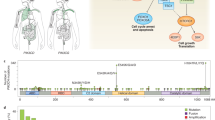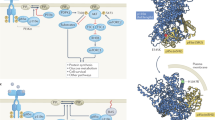Abstract
The phosphoinositide 3-kinase (PI3K)/AKT/mammalian target of rapamycin (mTOR) signaling pathway regulates proliferation, survival and metabolism, and its dysregulation is one of the most frequent oncogenic events across human malignancies. Over the last two decades, there has been significant focus on the clinical development of PI3K pathway inhibitors. More than 40 different inhibitors of this axis have reached various stages of clinical trials, but only a few of them have been approved by the Food and Drug Administration (FDA) for cancer treatment. These clinical results, however, could be improved given the importance of PI3K signaling in cancer and its role in linking cancer growth with metabolism. In this systematic review, after a glance at PI3K/AKT/mTOR pathway and its different inhibitors, we retrieved registered clinical trials evaluating the efficacy and safety of PI3K/AKT/mTOR inhibitors on Clinicaltrials.gov. Following the extraction of the data, finally we analyzed 2250 included studies in multiple steps, beginning with an overview and moving on to the details about type of malignancies, inhibitors, and treatment strategies. We also took a closer look at more than 100 phase III-IV clinical trials to pinpoint promising therapies, ho** that presenting a comprehensive picture of current clinical trials casts a flash of light on what remains to be done in future clinical trials of PI3K/AKT/mTOR inhibitors in human malignancies.











Similar content being viewed by others
Data availability
Data sharing is not applicable to this article as no new data was generated, or the article describes entirely theoretical research.
References
Akbari Dilmaghani N et al (2021) The PI3K/Akt/mTORC signaling axis in head and neck squamous cell carcinoma: Possibilities for therapeutic interventions either as single agents or in combination with conventional therapies. IUBMB Life 73(4):618–642
Arcaro A, Wymann MP (1993) Wortmannin is a potent phosphatidylinositol 3-kinase inhibitor: the role of phosphatidylinositol 3, 4, 5-trisphosphate in neutrophil responses. Biochem J 296(2):297–301
Castel P et al (2021) The present and future of PI3K inhibitors for cancer therapy. Nature Cancer 2(6):587–597
Chen J et al (2018) miR-21-5p confers doxorubicin resistance in gastric cancer cells by targeting PTEN and TIMP3. Int J Mol Med 41(4):1855–1866
Ciraolo E, Morello F, Hirsch E (2011) Present and future of PI3K pathway inhibition in cancer: perspectives and limitations. Curr Med Chem 18(18):2674–2685
Clayton E et al (2002) A crucial role for the p110δ subunit of phosphatidylinositol 3-kinase in B cell development and activation. J Exp Med 196(6):753–763
De Vera AA, Reznik SE (2019) Combining PI3K/Akt/mTOR inhibition with chemotherapy. Protein kinase inhibitors as sensitizing agents for chemotherapy. Elsevier, pp 229–242
Dharmamoorthy G et al (2022) A review on FDA approval of lymphoma drug ukoniq (Umbralisib) And Its withdrwal due to safety concerns. J Pharm Negat Results 13(4):1465–1474
Dienstmann R et al (2014) Picking the point of inhibition: a comparative review of PI3K/AKT/mTOR pathway inhibitorsdifferentiating PI3K/AKT/mTOR pathway inhibitors. Mol Cancer Ther 13(5):1021–1031
FDA withdrew its approval for the cancer medicine Ukoniq (umbralisib) due to safety concerns. 2022; Available from: https://bit.ly/3FC651c.
Hassan B et al (2013) Targeting the PI3-kinase/Akt/mTOR signaling pathway. Surg Oncol Clin 22(4):641–664
He Y et al (2021) Targeting PI3K/Akt signal transduction for cancer therapy. Signal Transduct Target Ther 6(1):425
Hillmann P, Fabbro D (2019) PI3K/mTOR pathway inhibition: opportunities in oncology and rare genetic diseases. Int J Mol Sci 20(22):5792
Hoxhaj G, Manning BD (2020) The PI3K–AKT network at the interface of oncogenic signalling and cancer metabolism. Nat Rev Cancer 20(2):74–88
Janku F (2017) Phosphoinositide 3-kinase (PI3K) pathway inhibitors in solid tumors: from laboratory to patients. Cancer Treat Rev 59:93–101
Janku F, Yap TA, Meric-Bernstam F (2018) Targeting the PI3K pathway in cancer: are we making headway? Nat Rev Clin Oncol 15(5):273–291
Khorasani ABS et al (2021) The PI3K/Akt/mTOR signaling pathway in gastric cancer; from oncogenic variations to the possibilities for pharmacologic interventions. Eur J Pharmacol 898:173983
Khwaja A (2011) PI3K as a target for therapy in haematological malignancies. Phosphoinositide 3-kinase in health and disease, vol 2. Springer, Berlin, pp 169–188
Kumar CC, Madison V (2005) AKT crystal structure and AKT-specific inhibitors. Oncogene 24(50):7493–7501
Massacesi C et al (2013) Challenges in the clinical development of PI3K inhibitors. Ann N Y Acad Sci 1280(1):19–23
Motzer RJ et al (2008) Efficacy of everolimus in advanced renal cell carcinoma: a double-blind, randomised, placebo-controlled phase III trial. The Lancet 372(9637):449–456
Nicholson KM, Anderson NG (2002) The protein kinase B/Akt signalling pathway in human malignancy. Cell Signal 14(5):381–395
Obenauer JC, Cantley LC, Yaffe MB (2003) Scansite 2.0: proteome-wide prediction of cell signaling interactions using short sequence motifs. Nucleic Acids Res 31(13):3635–3641
Oncologic drugs advisory committee meeting April 21, 2022. 2022; Available from: https://bit.ly/3Sfivyo.
Popova NV, Jücker M (2021) The role of mTOR signaling as a therapeutic target in cancer. Int J Mol Sci 22(4):1743
Romashkova JA, Makarov SS (1999) NF-κB is a target of AKT in anti-apoptotic PDGF signalling. Nature 401(6748):86–90
Roskoski R Jr (2021) Properties of FDA-approved small molecule phosphatidylinositol 3-kinase inhibitors prescribed for the treatment of malignancies. Pharmacol Res 168:105579
Sanaei MJ et al (2022a) The PI3K/Akt/mTOR axis in colorectal cancer: oncogenic alterations, non-coding RNAs, therapeutic opportunities, and the emerging role of nanoparticles. J Cell Physiol 237(3):1720–1752
Sanaei M-J et al (2022b) The PI3K/Akt/mTOR pathway in lung cancer; oncogenic alterations, therapeutic opportunities, challenges, and a glance at the application of nanoparticles. Transl Oncol 18:101364
Shouse G, Danilova OV, Danilov AV (2022) Current status of phosphoinotiside-3 kinase inhibitors in blood cancers. Curr Opin Oncol 34(5):540–545
Singh SS et al (2015) Targeting the PI3K/Akt signaling pathway in gastric carcinoma: a reality for personalized medicine? World J Gastroenterol 21(43):12261
Sirico M et al (2023) Current state and future challenges for PI3K inhibitors in cancer therapy. Cancers 15(3):703
Vasan N, Cantley LC (2022) At a crossroads: how to translate the roles of PI3K in oncogenic and metabolic signalling into improvements in cancer therapy. Nat Rev Clin Oncol 19(7):471–485
Vlahos CJ et al (1994) A specific inhibitor of phosphatidylinositol 3-kinase, 2-(4-morpholinyl)-8-phenyl-4H-1-benzopyran-4-one (LY294002). J Biol Chem 269(7):5241–5248
Wang L, Harris TE, Lawrence JC (2008) Regulation of proline-rich Akt substrate of 40 kDa (PRAS40) function by mammalian target of rapamycin complex 1 (mTORC1)-mediated phosphorylation. J Biol Chem 283(23):15619–15627
Weigelt B, Downward J (2012) Genomic determinants of PI3K pathway inhibitor response in cancer. Front Oncol 2:109
Xue C et al (2021) Crosstalk between circRNAs and the PI3K/AKT signaling pathway in cancer progression. Signal Transduct Target Ther 6(1):400
Zinda MJ et al (2001) AKT-1,-2, and-3 are expressed in both normal and tumor tissues of the lung, breast, prostate, and colon. Clin Cancer Res 7(8):2475–2479
Acknowledgements
The authors would like to express their gratitude to Shahid Beheshti University of Medical Sciences (Tehran, Iran) for supporting this study.
Author information
Authors and Affiliations
Contributions
ZD-M: Investigation (lead), Data gathering (lead), Writing – Original Draft Preparation (lead), Writing – Review & Editing (supporting); FJ-R: Investigation (lead), Data gathering (lead), Writing – Original Draft Preparation (lead), Writing – Review & Editing (supporting); MD: Investigation (lead), Data gathering (lead); AP-S: Data gathering (supporting); Designing figures and graphs; DB: Conceptualization (lead), Supervision (lead), Writing – Review & Editing (lead), Project Administration.
Corresponding author
Ethics declarations
Conflict of interest
The authors declare that they have no conflict of interest.
Additional information
Publisher's Note
Springer Nature remains neutral with regard to jurisdictional claims in published maps and institutional affiliations.
Supplementary Information
Below is the link to the electronic supplementary material.
Rights and permissions
Springer Nature or its licensor (e.g. a society or other partner) holds exclusive rights to this article under a publishing agreement with the author(s) or other rightsholder(s); author self-archiving of the accepted manuscript version of this article is solely governed by the terms of such publishing agreement and applicable law.
About this article
Cite this article
Davoodi-Moghaddam, Z., Jafari-Raddani, F., Delshad, M. et al. Inhibitors of the PI3K/AKT/mTOR pathway in human malignancies; trend of current clinical trials. J Cancer Res Clin Oncol 149, 15293–15310 (2023). https://doi.org/10.1007/s00432-023-05277-x
Received:
Accepted:
Published:
Issue Date:
DOI: https://doi.org/10.1007/s00432-023-05277-x




